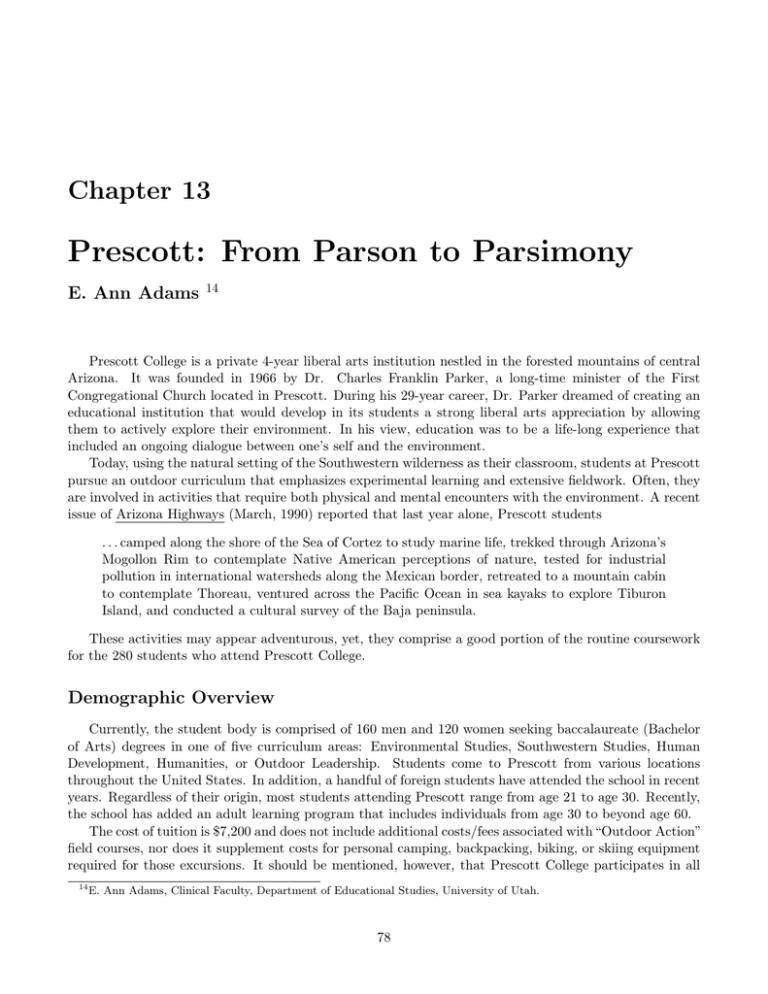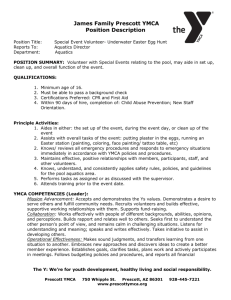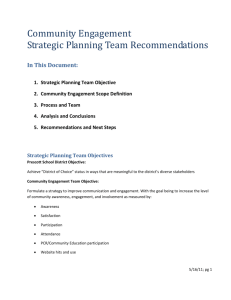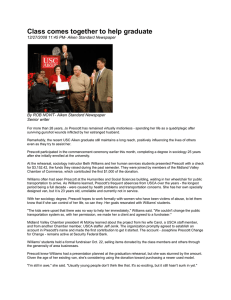Prescott: From Parson to Parsimony
advertisement

Chapter 13 Prescott: From Parson to Parsimony E. Ann Adams 14 Prescott College is a private 4-year liberal arts institution nestled in the forested mountains of central Arizona. It was founded in 1966 by Dr. Charles Franklin Parker, a long-time minister of the First Congregational Church located in Prescott. During his 29-year career, Dr. Parker dreamed of creating an educational institution that would develop in its students a strong liberal arts appreciation by allowing them to actively explore their environment. In his view, education was to be a life-long experience that included an ongoing dialogue between one’s self and the environment. Today, using the natural setting of the Southwestern wilderness as their classroom, students at Prescott pursue an outdoor curriculum that emphasizes experimental learning and extensive fieldwork. Often, they are involved in activities that require both physical and mental encounters with the environment. A recent issue of Arizona Highways (March, 1990) reported that last year alone, Prescott students . . . camped along the shore of the Sea of Cortez to study marine life, trekked through Arizona’s Mogollon Rim to contemplate Native American perceptions of nature, tested for industrial pollution in international watersheds along the Mexican border, retreated to a mountain cabin to contemplate Thoreau, ventured across the Pacific Ocean in sea kayaks to explore Tiburon Island, and conducted a cultural survey of the Baja peninsula. These activities may appear adventurous, yet, they comprise a good portion of the routine coursework for the 280 students who attend Prescott College. Demographic Overview Currently, the student body is comprised of 160 men and 120 women seeking baccalaureate (Bachelor of Arts) degrees in one of five curriculum areas: Environmental Studies, Southwestern Studies, Human Development, Humanities, or Outdoor Leadership. Students come to Prescott from various locations throughout the United States. In addition, a handful of foreign students have attended the school in recent years. Regardless of their origin, most students attending Prescott range from age 21 to age 30. Recently, the school has added an adult learning program that includes individuals from age 30 to beyond age 60. The cost of tuition is $7,200 and does not include additional costs/fees associated with “Outdoor Action” field courses, nor does it supplement costs for personal camping, backpacking, biking, or skiing equipment required for those excursions. It should be mentioned, however, that Prescott College participates in all 14 E. Ann Adams, Clinical Faculty, Department of Educational Studies, University of Utah. 78 of the available Title IV financial aid programs. In fact, half the students receive some type of financial assistance. The admissions process takes place in the fall and again in the spring. Requirements for admission include: either graduation from high school or a GED, a 500-word essay describing the student’s educational goals, why he/she wishes to attend Prescott, and how Prescott can help him/her to achieve academic and personal goals, official transcripts of all high school and college coursework completed, and two recent letters of recommendation. In addition, prospective students are encouraged to arrange for a personal interview. Applicants are also required to pass a basic mathematics and an English composition exam. Should students fail to demonstrate competency in these areas, they are required to complete preparatory courses in both disciplines and repeat the testing process. Prescott does not cater to an intellectual elite, nor to any specific applicant pool. In fact, it accepts and admits 85-90 percent of all who apply. Most of the students who come to Prescott are outdoor types, intrigued by the non-traditional, personalized approaches being employed at the school. According to the Admissions Director, students are attracted to the college because it values small classes (a student-faculty ratio of 10:1), student self-direction, an interdisciplinary approach, and hands-on learning (Janssen, 1991). Of the 28 faculty members that comprise the teaching staff at Prescott in 1991, 11 hold doctorate degrees, 13 have master’s degrees, and 4 are teaching with baccalaureate degrees. The college also employs a small number of adjunct staff to further enrich its curriculum within certain specialties. Instructors teach in their own area of expertise; however, there are a number of opportunities for them to cross interdisciplinary lines. Not unlike the student body, faculty members also represent many states of the union and are drawn to Prescott because they enjoy the natural environment. They believe in the power of experiential learning, have noted its impact on student growth, and relish the strong sense of community that is felt across the 2.5-acre campus. With regard to financial concerns, Prescott College functions within a $4.5 million budget. Most of the revenue (89 percent) is generated from student tuition and fees, while some (10 percent) is obtained from unrestricted private gifts. Approximately 1 percent comes to the school from state/local appropriations. In addition to these monetary possessions, Prescott also holds as assets its buildings, grounds, and equipment. These properties add an estimated value of $400,000 to the total operating budget. Currently, the school is on sound footing. It was recently recognized in Money magazine’s Guide to American Colleges as “one of the top 100 private schools for your money.” A major concern has surfaced with Prescott’s newfound notoriety. There is the fear that growth may follow success. If this should occur, it is doubtful that the institution would have the ability to expand its physical facilities quickly enough to meet the demands of an overflowing population. Moreover, growth would certainly inhibit Prescott’s ability to deliver the unique academic programs that have made its rapid ascent possible. Philosophical Roots In early autumn of 1963, Charles Franklin Parker received a $15,000 grant from the Ford Foundation to begin planning for Prescott College. Specifically, this money was to be used to support an Academic Sym­ posium wherein a group of community leaders, an Academic Advisory Council, and members of Prescott’s board of trustees would gather to complete three important tasks: 1) assist Prescott College planners in determining a workable definition for a 4-year liberal arts college, 2) define the purposes, academic pro­ grams, and methods useful in relating the institution to the environment of the Southwest region, and 3) orient the new college with the great traditions of other institutions without constricting the vision of the inchoate Prescott College. Hoping to formulate plans within these general guidelines, participants in the symposium assembled 79 at the Camelback Inn in Phoenix, Arizona on November 7, 8, and 9, 1963. Approximately 90 individuals attended to collectively consider what they perceived to be the ideal liberal arts college. Dr. Parker, as founding president, delivered the opening address. Throughout his remarks, he upheld his Judeo-Christian tradition, yet, appeared mindful of his opportunity to establish new patterns of thought and behavior. The United Church of Christ or the Congregationalist Church was to be the spiritual and ideological godparent of Prescott College. Hence, a Christian atmosphere with moral and spiritual emphasis was to provide the means for “obtaining light and truth from His holy word” (Parker, 1965). Still, Parker anticipated societal demands and changes that would require a new Congregationalist college with a uniqueness, a creative set of standards, and a commitment to spiritual, cultural, and environmental circumstances. Furthermore, he predicted that Prescott would offer an aggressive and flexible liberal arts curriculum. In an effort to design what he termed to be a creative, academic community, Parker offered the following suggestions (Parker, 1965): 1. The college should be co-educational. 2. Classes should be small to promote intimate, tutorial relations between students and faculty. 3. Modern techniques of group and individual instruction should be utilized. 4. Living facilities should be small to encourage personal, social relationships. 5. The institution and its clientele should reflect good moral standards and wholesomeness in both formal and informal activities. 6. There should exist a community of scholarly sharing wherein students and faculty become excited about searching and questioning; attainment of knowledge was to be “as thrilling as a Saturday night football game.” 7. There should be considerable confrontation between the disciplines or“interdisciplinary cross-fertilization.” 8. Students and faculty should share respect and agreeableness as they search out the truth. 9. Each student should be given the privilege and prerogative of becoming the finest individual possible. Faculty members must allow for individual growth (even if it leads to non-conformity). 10. Develop a respect for the diversity of people, religions, and nations, and work at improving commu­ nications among those groups. 11. Use the region of the Southwest as a laboratory for studying cultural differences among Indian tribes, Spanish cultures, Anglo-Americans, and other inhabitants. 12. Create a sense of belonging even for those labeled as different. 13. Provide continued learning experiences for graduates, develop their imaginations and curiosity in such a way that they become “life-long” learners. Dr. Parker closed his speech by proposing a motto for his newfound institution: “Freedom Through Faith and Knowledge.”“Freedom” was representative of the right of the individual to grow, “faith” was in reference to the moral values that one should acquire as practical guides for living, and “knowledge” was related to attaining a better understanding of the world through actual experience. Following Dr. Parker’s concluding remarks, selected participants were invited to address the group. The purpose of these presentations was to provide background information about the geographical, agricultural, 80 and economic aspects of the Southwestern region. Additional speakers were called upon to provide further insight regarding curriculum concerns and current issues in higher education. Then, the participants were divided into five panels: the humanists, the physical scientists, the social scientists, the administrators, and the plant planners. Expert panelists in each of these areas were asked to meet independently to discuss subject matter, share educational philosophies, and review the suggestions presented by Dr. Parker and others. Ultimately, from their recommendations, would emerge the profile of a new, liberal arts college. The Academic Program In terms of the geographical area, the founders of Prescott College believed that the unique physical environment of the Southwest provided unparalleled opportunities for study and research in the natural sciences and in the humanities. The wide variety of faunal and floral specimens indigenous to the region would certainly provide a natural laboratory for zoologists and botanists. Likewise, the volcanic fields, deserts, and high plateaus could offer geologists and geographers an exciting arena for conducting their work. And Arizona, with its rich cultural history of American Indian tribes, would furnish a natural laboratory for the development of future historians, anthropologists, and other social scientists (Euler, 1965). Moreover, participants at the symposium felt that placing students in an untamed wilderness would cause them to ponder the meaning of their existence, to become more sensitive to the beauty that sur­ rounds them, and to develop a reverence for life and creation. Furthermore, it was thought that field experiences would remove students from a hectic and mechanized existence and place them in situations where they would have to rely upon their own resourcefulness and adaptability. It was hoped that these combined experiences would produce knowledgeable individuals who not only had an appreciation for their environment but also a desire to make the world a better place. The founders of Prescott adamantly favored the establishment of a unified and diverse curriculum in which no dichotomy would exist between the sciences and the humanities. From their perspective, it was imperative that students acquire a clear understanding of interdisciplinary relationships. This seemed especially pertinent when considering the development of civilizations. In the words of one Symposium participant, “without the physical world there would be no living beings, without living beings there would be no society, and without society there would be no artistic or literary expression” (Parker, 1965). Hence, Prescott chose to depart from the traditional departmental divisions and narrow specializations that existed in other contemporary institutions. As a result of adopting an integrated curriculum, the breadth and depth of a student’s educational experience were expanded. It was also decided that Prescott’s emphasis should lie with a holistic approach to education. The founders vowed to avoid the kind of pre-professional and vocational training offered by some state colleges. Instead, they were committed to a more worthwhile enterprise: the development of the whole person. In order to accomplish this goal, symposium panelists agreed that curriculum offerings at the College should provide the means for students to not only acquire knowledge, but also develop the intellectual skills necessary to think critically. In addition, they felt it necessary for students to be exposed to a variety of life experiences outside of the classroom in order to become more broadly educated. In their view, these experiences would lead the individual to heightened levels of self-awareness and social consciousness. In order to facilitate knowledge acquisition and the experiential learning component, Prescott College adopted a unique academic calendar consisting of two, 10-week quarters (fall and spring) in which theoretical knowledge was to be acquired; and three, one-month blocks (fall, winter, and spring) during which field experiences were to take place. A third component that was to be integrated into the curriculum was flexibility. The founders were fearful that any form of regimentation would stifle individuality. In an effort to prevent this from occurring, 81 the founders of Prescott adopted a policy that allowed students to plan, within broad curriculum guidelines, their own programs of study. There were to be no required courses. Instead, students were free to design their own coursework by selecting from a wide variety of electives. It was recommended that each student be assigned to a faculty member to assist them in this regard. Through this process, it was hoped that students might be encouraged to develop their own unique interests, talents, and abilities. With respect to teaching/learning approaches, instructors at Prescott were not to concern themselves with imparting facts. Rather, they were to incorporate Socratic techniques that would prompt students to employ reasoning and problem-solving skills while learning. According to one presenter, learning would result from investigation, analysis, and application (Parker, 1965). The application component mentioned here refers to the fieldwork experience that is incorporated into each student’s program of study. The structure of the curriculum at Prescott also requires an interdisciplinary approach to learning. As a result, teachers are required to relate academic disciplines by stressing the overlap that exists across academic areas such as science, social science, and the humanities. In order for these approaches to be effective, the size of classes are small and instructors must be willing to form open, tutorial relationships with their students. These preceptorships are especially critical to learners at Prescott where “education is an experience that takes place between and among people” (Parker, 1965). Furthermore, faculty members are not only required to possess knowledge and skills relative to their own field of study, but, must also have acquired a broad understanding of other disciplines. Since the primary focal point for learning is placed on competence and mastery as opposed to credits, letter grades are nonexistent. Instead, pupils receive a summative evaluation from their instructor(s) at the completion of each course. Students also submit a self-evaluation reviewing their work and accomplish­ ments. Toward the end of their coursework, during their senior year, students are encouraged to complete internships and service projects that may be conducted within the Prescott community, or as far away as Antarctica. These experiences vary in length from a semester to over 1 year. The internship/service experience allows students to apply their knowledge and skills, and test their career choices early. In the past, many students at Prescott have returned to their internship/service project sponsors for postgraduate employment. The faculty employed at Prescott belong to an egalitarian structure wherein all receive the same salary and benefits package (valued at $22,000/year) regardless of their responsibilities, longevity, or seniority. There are no titles and no academic divisions—even though original appointments are made specific to one’s field of expertise. Faculty members at Prescott are hired for one specific task: teaching. Obviously, this includes organizing and accompanying students on field experiences and serving on student advisory committees. There is no research requirement, although instructors are expected to stay current in their own fields as well as other disciplines. Most of the faculty currently on staff at Prescott are relatively young (late 30s, early 40s). This might be due to the school’s modest compensation plan. It is interesting to note a statement made by one symposium panelist who recommended that Prescott’s first instructors be seasoned and experienced, middle-aged close to retirement aged individuals who can later be replaced by young, able faculty who will bring fresh, new insights to our school (Parker, 1965). Given the attrition rate over the past 10 years, it appears that that moment has arrived. The administrative panel that gathered in 1963 perceived their purpose as providing organizational structures and orderly procedures necessary to keep the college functioning (Parker, 1965). Beyond this general declaration, they offered few guidelines for establishing an administrative hierarchy. This action could be viewed as a symbolic gesture. Perhaps the founders were sending the message that administrative bodies at the college level should not interfere in the curricular issues that were central to the purpose of the Symposium. Nevertheless, within the first couple of years Dr. Parker had developed a workable governance structure 82 following guidelines proposed by the administrative panelists. It consisted of trustees, a college president, and a vice-president. The locus of power was clearly located with the president and board of trustees. The trustees were granted authority to formulate policies, select administrative officers, and handle public relations for the College. In turn the president’s responsibilities included the appointment/dismissal of teachers, budget appropriations, and general administrative tasks. The sole responsibility of the vicepresident was fund-raising. During Prescott’s formative years, students were not involved in administrative decisions, however, they became more entangled in school affairs later on. The Academic Symposium held in November 1963 was the formative event in the history of Prescott College. Participants at that meeting offered suggestions and made recommendations that became the strong philosophical base that continues to guide the College today. In the next section the survival of Prescott will be attributed to the stalwart commitment of the student body, faculty, and administration to those concepts proposed nearly 30 years ago. Historical Evolution Prescott College became chartered and offered its first instruction in the autumn of 1966. From this date until the early 1970s, the school was in its formative stages. Time and money were spent on erecting buildings and expanding campus facilities. The institution’s founder, Charles Franklin Parker, opened the school with a $1.5 million budget. Most financial support was obtained from local ranchers and business people in Arizona along with a handful of East Coast investors that had strong ties with the Congregationalist Church of New England. Other monies had been obtained through grants and small-scale fund-raising activities. It is interesting to note that beyond these early years, the Church and its New England traditions had little influence over the college. Undoubtedly, this is attributed to Parker’s practice of appointing others to manage his institution while he spent his time publishing theology books. As nondenominational presidents began leading the school in the early 1970s, Prescott gracefully discontinued contact with the Congregationalists. The College has, however, maintained open relations with New England benefactors and established financial contacts with various business organizations and corporations across the United States. In fact, Prescott currently has a number of these individuals serving on its board. With the exception of the Congregationalist traditions that were present at the Symposium of 1963, Prescott College has remained consistent with all of the philosophical groundwork laid by its founders. Over its 25 year history, it has remained committed to the education of the whole person. It has allowed students to apply their acquired knowledge and skills in experiential learning situations and has employed an interdisciplinary approach with regard to curriculum. The school has also recognized the importance of involving students in planning educational programs around their unique goals, interests, and talents. These methodologies, implemented since the origination of the college, have provided direction and emerged as part of its valued traditions. In 1974, circumstances arose that enabled Prescott College to test the strength of its purpose. The president during this time was an authoritative individual named Ronald Nairn. He was a brilliant and charismatic leader who claimed to be the youngest person to have received a Ph.D. from Yale University. He was also a personal friend of Barry Goldwater and used his political contacts to generate national interest and financial support for Prescott College. In fact, millions of dollars were raised during his presidency. Unfortunately, Dr. Nairn was a poor financial manager. During his term as college president, he managed to accrue a $5 million debt. In an attempt to “cover Parker’s shadow,” the Machiavellian leader overspent his budget by erecting new buildings and by reorganizing the school into three different colleges, for which new administrators and faculty were hired. Because of his stubborn and cantankerous personality, Dr. Nairn had frequent conflicts with his subordinates and trustees. In fact, at one point three of his vice­ 83 presidents terminated their contracts with the school (Stuckey, 1991). Nairn’s rampant spending included paying individual scholars $2,000 to travel to Prescott and present two-day seminars held at various times throughout the academic year. To make matters worse, Dr. Nairn had fallen prey to a “wealthy” married couple from Chicago, Henry and Barbara Lowther, who were interested in the unique programs offered by the school and wanted to rescue Prescott from its pending financial collapse. The president and the board were desperate and could find no reason to refuse their generosity. As a result, they allowed the couple to invest money in the school. In the process, the couple finagled the bank into placing their names on Prescott’s accounts (Maerzke, 1991). Within a matter of days, they cashed checks totaling hundreds of thousands of dollars and reneged on their promise to pay the college’s insurance premium that had come due. Posthumously, it was discovered that the Lowthers were on probationary status from an Illinois court for an earlier stock fraud conviction. Luckily, they were confronted short of completely destroying Prescott College (Stuckey, 1991). Understandably, the College rapidly lost support. The financial woes, coupled with the surrounding community’s disgruntled attitude toward the “hippie” clientele that flocked to the school during this period, required action from the board of trustees. In response, Nairn was fired. An acting president, Frank Mertz, was appointed, and the school was granted a 6-month period in which to correct its situation. About this time, faculty members decided to take matters into their own hands. To help the school conserve its financial resources, they agreed to surrender a portion of their salaries. They also organized several ad hoc committees of administrators, faculty members, and students to restructure the college. In addition, the faculty spearheaded a series of fund-raising campaigns to raise enough revenue to keep the school open. Their most celebrated effort took place on the college’s soccer field as they gathered with students to “curse the Lowthers” and “pass the hat.” The collection resulted in loose change and one-dollar bills totaling $320 (Stuckey, 1991). Unfortunately, their efforts fell short. By autumn’s end in 1974, Prescott had lost its property, its buildings, and all of its physical assets. The institution had no alternative but to declare bankruptcy and surrender its accreditation rights. Amazingly, even though the campus was closed, the school continued to function. This was due to a committed faculty (whose living rooms were converted to classrooms) and to a determined student body that refused to allow their college to die. For the next several months, students attended classes at their instructors’ homes, in the basement of a local hotel, and at a nearby community college that had sympathetically donated classroom space for Prescott’s use (Maerzke, 1991). Meanwhile, various financiers from across the country were informed of Prescott’s misfortune and money began to trickle in. Most donors were either carry-overs from the Goldwater connection, parents of the student body, or former graduates of the college. Others had become so impressed with the demeanor of Prescott students that they vowed to support the school. One New York contributor, for example, met a Prescott graduate who was serving as a boatman on a river-running expedition. After spending several days with the young man, the donor expressed his desire to contribute to a college “capable of producing such fine individuals” (Stuckey, 1991). Funds obtained from these interested parties, along with those raised through local efforts, literally resurrected the College. In the spring of 1975, Prescott College officially reopened with an enrollment of 50 students. During that same year, the College was re-accredited by the North Central Association of Colleges. An influential Prescott trustee, Herman Bleibtreu, was instrumental in regaining the suspended accreditation rights. At the time Dr. Bleibtreu was serving on board, he was also a full-time faculty member at the University of Arizona. He approached the North Central Association of Colleges’ accrediting team and threatened to withdraw the University’s membership if they failed to sign the diplomas of the 1975 Prescott graduates. Rather than risk losing accreditation rights to the University of Arizona, along with other prominent institutions in the state, the North Central Association of Colleges conceded, signed the diplomas, and reinstated Prescott College (Maerzke, 1991). The years following 1975 reflected a renaissance that profoundly affected Prescott. A renewed sense of 84 commitment arose as students, faculty, and administrative committees continued to adopt precautionary measures to ensure the school’s longevity. Changes in the administrative structure, a heightened concern for environmental issues, and the addition of new degree programs had a dramatic impact on the College. As a result of the problems encountered during 1974-75, the power structures originally erected at Prescott have completely changed. The board of trustees has become the board of directors, the president is on a first name basis with the student body, and a “big, happy family” attitude abounds across the campus. Furthermore, instead of the locus of power resting upon the president and the board of directors, control has been diffused to various levels across the organization. For example, students and four faculty members are elected to positions on the board of directors. In addition, weekly student meetings are held at the college chapel, providing a forum in which students can voice concerns and discuss issues with representatives from the board. This post-1974 restructuring effort has not only created a system of checks and balances within the administration, but it has also allowed for student and faculty input into the decision-making process. As public awareness of environmental issues has increased over the last decade, Prescott has grown in both popularity and in enrollment. The natural setting of the school and its emphasis on wilderness experiences has become very appealing to budding environmentalists seeking a nontraditional, college experience. In response, Prescott has changed its motto from Parker’s “Freedom Through Faith and Knowledge” to “Prescott College: For the Liberal Arts and the Environment.” At the same time, it has instituted a “Wilderness Orientation” class wherein small groups of new students are led by instructors and advanced students on a 18 day expedition through the isolated mountains and canyons of the desert Southwest. It should be mentioned that this is a required, freshmen course used to familiarize students with the geographical area and introduce them to experiential-learning techniques. The changed motto and the establishment of this new course are indicative of Prescott’s heightened commitment to environmental education. In an attempt to better serve its community, Prescott has added two new degree programs. First, is the Adult Degree Program that was designed for individuals whose work schedules make it impossible for them to complete a regular college program. Students in this program are given opportunities to earn credit for time spent in the work setting while completing a series of independent study courses. Students who have previously earned baccalaureate degrees commonly use this program to obtain their teaching credential. Second, the College has responded to the needs of Southwestern Native Americans by making the Adult Degree Program available to them. This 2-year program is intended to train and certify Indian instructors to teach on their reservations. The program has been funded by the U.S. Department of Education in an effort to counteract the 75 percent attrition rate that exists for Indian students attending American colleges. The addition of these two programs, along with society’s increased attention toward environmental issues, has caused the enrollment at Prescott to climb dramatically. It is quite apparent that the College has successfully overcome the crisis it faced 17 years ago. Indeed, Prescott owes its survival to the financial support it received from local donations and national benefactors. It is also indebted to a committed student body and a unified faculty that remained steadfast and true to the values and philosophies prescribed by the institution’s founders. Assessment Prescott College’s systematic method for assessing effectiveness is the accreditation process imposed by the North Central Association of Colleges and Schools. This evaluation occurs every three to 10 years and is conducted by a team of educational experts. Prescott’s most recent accreditation took place this past year and the school received a maximum vote of confidence (10 years) from the accrediting team. 85 In its report, the North Central Association referred to the college as a beacon for higher education and applauded its unique programs for being on the cutting edge of educational philosophy in America. The sole recommendation offered by the accrediting team was for Prescott to broaden the membership of the board of directors to reflect national influence instead of a regional focus (Pieper, 1990). This is likely to occur as the school continues to gain national recognition. Prescott’s opinion of itself may best be reflected in the words of current president Doug North, a graduate from Yale University and a former faculty member at Goddard College. He describes the college as an “innovative institution that is palpably vibrant with energy and excitement; a college that places emphasis on teaching and learning, and concerns itself with producing individuals capable of creating and managing change rather than preserving the status quo” (Janssen and Maerzke, 1990). In addition to the accrediting team’s commendations and Dr. North’s statements, the institution has made formal attempts to measure its own effectiveness. However, these efforts have fallen short. Most have come in the form of self-studies and result in little more than brief histories of the school. Clearly, this is one area where Prescott needs to improve. Presently, the College relies on enrollment figures and commendations from alumni and students to gauge its achievement. In terms of enrollment, the 187 students that attended Prescott in 1985 more than tripled to 642 in 1990. These figures represent total enrollment, including both Adult Degree programs. In spite of its rapid growth, alumni and members of the student body continue to compliment the college for its ability to produce self-directed and active learners who are motivated to make a difference in the world. One individual interviewed for this report revealed that his experience at Prescott had changed his view of himself. He stated that, “learning in an environment where thinking is encouraged has taught me to think for myself. As a result, I have come to trust my own mental capacities” (Packard, 1991). While the accreditation team’s report, the president’s remarks, enrollment figures, and alumni/student evaluations may be positive indicators, they are hardly accurate measures for effectiveness. Until the school develops more sophisticated means of gathering this data, it will continue to produce saccharine self-evaluations. In any event, the manner in which information is disclosed in campus news articles, in the course catalog, and in the words of former students reveal that Prescott has a rather high opinion of itself. In contrast to these positive perspectives, some characteristics of the school warrant critical consider­ ation. First, there are the rather lax admission requirements that allow almost anyone with a high school diploma or GED to be accepted. As a result of these easy standards, Prescott may be sending the message that their academic curriculum is not as vigorous, nor as demanding, as other liberal arts programs. Sec­ ond, there is concern that too much emphasis is placed on outdoor activities and environmental studies. Some critics question the appropriateness of the field component as a viable means for acquiring essential knowledge and critical concepts from a variety of academic disciplines. A curriculum that incorporates hiking, biking, and mountain climbing as part of the learning experience leaves one wondering if Prescott exists as little more than a glorified, outward-bound program. Third, the open and friendly environment in which students at Prescott function may make for a difficult transition as they reenter a competitive world at the time of their graduation. Nevertheless, enrollment figures continue to rise as a reflection of the school’s popularity. There is concern, however, that increasing growth will require changes that may prove detrimental to Prescott College. Class size will increase and adjustments in the curriculum will be necessary to accommodate larger numbers. These alterations could undermine Prescott’s ability to deliver the unique and creative programs offered in the past. Furthermore, the campus facilities need to be expanded and this will bring substantial expense. Given the shaky financial history of the institution, faculty and students are fearful of the implications and the shadow of the 1974 debacle. Prescott has entered another critical stage. The current choices will hold serious implications for the future. In order to preserve consistent values, Prescott must continue to rely upon the keen sense of community, ownership, and collegiality which bind the institution together. These strengths will play a 86 vital role in the survival of Prescott College. 87 MIT OpenCourseWare http://ocw.mit.edu ES.291 Learning Seminar: Experiments in Education Spring 2003 For information about citing these materials or our Terms of Use, visit: http://ocw.mit.edu/terms.






